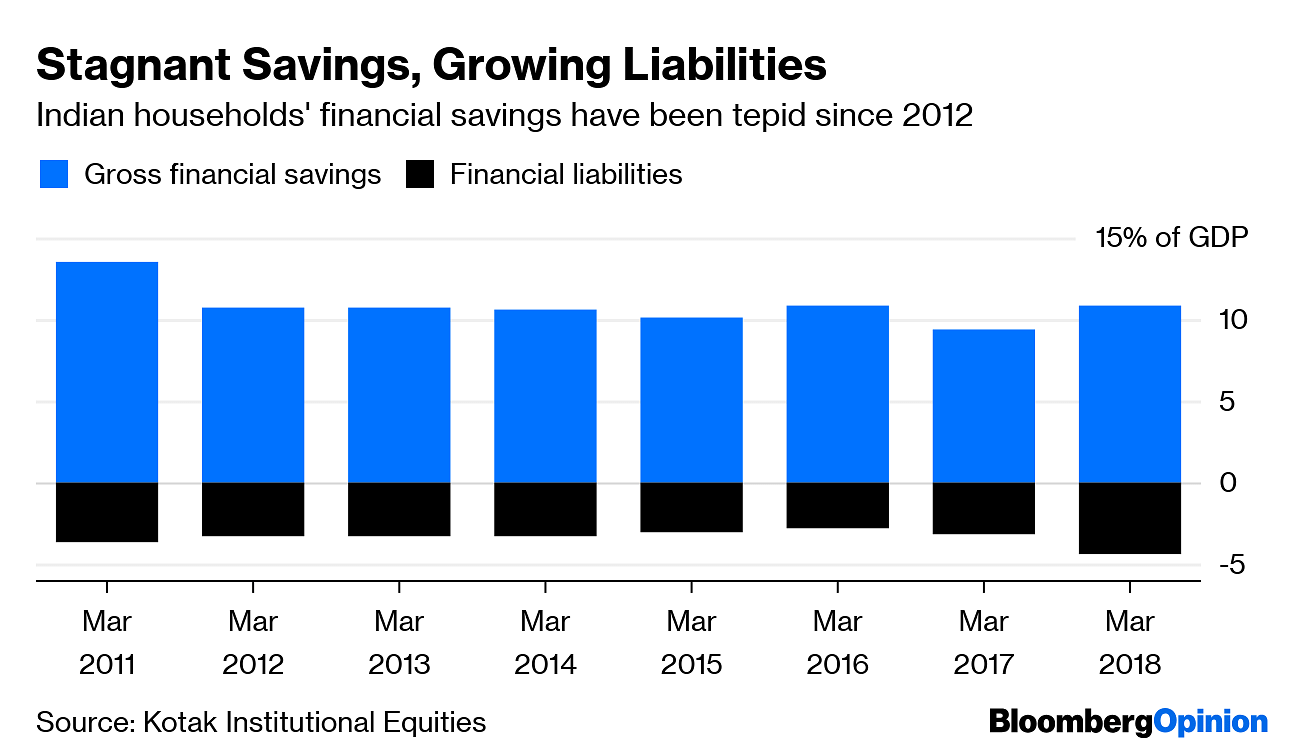India’s corporate funding market is what Winston Churchill might have described as a riddle, wrapped in a mystery, inside an enigma.
The riddle, according to India Ratings and Research Pvt., a unit of Fitch Ratings Inc., is that borrowers’ credit metrics aren’t likely to worsen from here. And yet in the financial year starting April 1, their borrowing costs may rise even if the central bank cuts policy rates further.
India Ratings’ researchers Arindam Som, Priyanka Poddar and Soumyajit Niyogi have attempted to solve the puzzle by looking at demand and supply of funds. There’s likely to be a sizable mismatch, they say, as pumped-up government borrowings – as well as debt issuance by public agencies, which I wrote about here – crowd out private borrowers. Besides, investors are parking less money with mutual funds. Any shrinkage in their assets under management will compound the financing challenge.
There’s a further mystery on the supply side of the funding equation. Households’ financial savings have languished between 9 percent and 11 percent of GDP since 2012. Brokerage Kotak Securities Ltd. can’t pinpoint why Indians aren’t saving more despite real interest rates of more than 5 percent. It might, the analysts say, have something to do with a 1-percent-of-GDP surge in their liabilities, combined with tepid job creation and the weak bargaining power of labor, which has become a global phenomenon. Those who don’t have enough cash after servicing loans for mortgages and two-wheelers can’t take advantage of high interest rates on bank deposits.

Then there’s the enigma of mistimed regulatory tightening. Starting April 1, the market regulator wants large companies to issue bonds to meet at least a fourth of their borrowing needs. This will help create a more liquid debt market, improve the pricing of credit, and reduce the outsize role of banks in project finance. Still, the requirement, if adopted in full, could exacerbate next year’s demand-supply gap in the capital market to around 1 trillion rupees ($14 billion), India Ratings estimates.
Starting July 1, the Reserve Bank of India wants banks to convert 60 percent of working capital limits above a threshold into loans with fixed maturities. It’s a sensible move. Overdrafts seldom test the true liquidity position of a borrower who pays interest but never returns the principal. Loans, meanwhile, give lenders a better handle on the cash flows of a business.
Yet companies may find it challenging to roll over around 1.9 trillion rupees of maturing loans in the coming financial year. This funding will mainly be needed by sectors such as gems and jewelry, property developers, construction firms and farm-commodity businesses, among others.
How can India get past its corporate-financing hump? The answer may lie in the general elections to be held between April 11 and May 19. A market-pleasing outcome on May 23 and higher stock prices could encourage businesses to bring in more equity, something many have been loath to do because of a narrowing gap between return on capital and borrowing costs. New capital expenditure – especially when it’s not merely for maintenance of existing facilities – will create jobs, thus boosting households’ financial savings. Companies will get financed.
Keep an eye on the latest decision by State Bank of India, the nation’s largest lender, to link some savings deposits and working-capital loans to the central bank’s repurchase rate from May 1. Other banks will follow suit. As the use of the policy rate expands to cover retail loans and time deposits, borrowers who got only a token 10-basis-point benefit of a 25-basis-point reduction in the repurchase rate in February should see faster drops in their cost of capital.
The way to solve the riddle, mystery and enigma is to treat them as the same problem: comatose animal spirits. The ongoing, simultaneous easing of fiscal and monetary policies may help, but only so far. The quality of political leadership will matter more. The tempo for India’s corporate credit is going to be set by the next government.
Also read: A key source of funding for India Inc. founders is drying up







Reminded of a story by H H Munro who wrote under the Pseudonym Saki, ATurkish Catastrophe, nothing much has changed in our country and one hope it does to have a majority in the center. That said, fear always lurks if the central power to deliver.